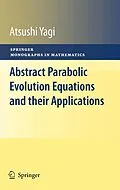The semigroup methods are known as a powerful tool for analyzing nonlinear diffusion equations and systems. The author has studied abstract parabolic evolution equations and their applications to nonlinear diffusion equations and systems for more than 30 years. He gives first, after reviewing the theory of analytic semigroups, an overview of the theories of linear, semilinear and quasilinear abstract parabolic evolution equations as well as general strategies for constructing dynamical systems, attractors and stable-unstable manifolds associated with those nonlinear evolution equations.
In the second half of the book, he shows how to apply the abstract results to various models in the real world focusing on various self-organization models: semiconductor model, activator-inhibitor model, B-Z reaction model, forest kinematic model, chemotaxis model, termite mound building model, phase transition model, and Lotka-Volterra competition model. The process and techniques are explained concretely in order to analyze nonlinear diffusion models by using the methods of abstract evolution equations.
Thus the present book fills the gaps of related titles that either treat only very theoretical examples of equations or introduce many interesting models from Biology and Ecology, but do not base analytical arguments upon rigorous mathematical theories.
Zusammenfassung
This monograph is intended to present the fundamentals of the theory of abstract parabolic evolution equations and to show how to apply to various nonlinear dif- sion equations and systems arising in science. The theory gives us a uni?ed and s- tematic treatment for concrete nonlinear diffusion models. Three main approaches are known to the abstract parabolic evolution equations, namely, the semigroup methods, the variational methods, and the methods of using operational equations. In order to keep the volume of the monograph in reasonable length, we will focus on the semigroup methods. For other two approaches, see the related references in Bibliography. The semigroup methods, which go back to the invention of the analytic se- groups in the middle of the last century, are characterized by precise formulas representing the solutions of the Cauchy problem for evolution equations. The ?tA analytic semigroup e generated by a linear operator ?A provides directly a fundamental solution to the Cauchy problem for an autonomous linear e- dU lution equation, +AU =F(t), 0
Inhalt
Preliminaries.- Sectorial Operators.- Linear Evolution Equations.- Semilinear Evolution Equations.- Quasilinear Evolution Equations.- Dynamical Systems.- Numerical Analysis.- Semiconductor Models.- ActivatorInhibitor Models.- BelousovZhabotinskii Reaction Models.- Forest Kinematic Model.- Chemotaxis Models.- Termite Mound Building Model.- Adsorbate-Induced Phase Transition Model.- LotkaVolterra Competition Model with Cross-Diffusion.- Characterization of Domains of Fractional Powers.
